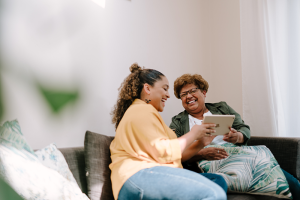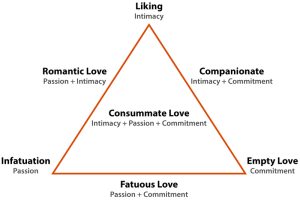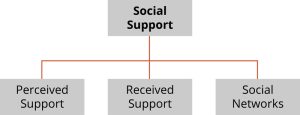17 Love, Friendship, and Social Support
Friendship and love, and more broadly, the relationships that people cultivate in their lives, are some of the most valuable treasures a person can own. This module explores ways in which we try to understand how friendships form, what attracts one person to another, and how love develops. It also explores how the Internet influences how we meet people and develop deep relationships. Finally, this module will examine social support and how this can help many through the hardest times and help make the best times even better.
Learning Objectives
- Understand what attracts us to others.
- Review research that suggests that friendships are important for our health and well-being.
- Examine the influence of the Internet on friendship and developing relationships.
- Understand what happens to our brains when we are in love.
- Consider the complexity of love.
- Examine the construct and components of social support.
Introduction

The importance of relationships has been examined by researchers for decades. Many researchers point to sociologist Émile Durkheim’s classic study of suicide and social ties (1951) as a starting point for this work. Durkheim argued that being socially connected is imperative to achieving personal well-being. In fact, he argued that a person who has no close relationships is likely a person who is at risk for suicide. It is those relationships that give a person meaning in their life. In other words, suicide tends to be higher among those who become disconnected from society. What is interesting about that notion is when people are asked to describe the basic necessities for life—people will most often say food, water, and shelter, but seldom do people list “close relationships” in the top three. Yet time and time again, research has demonstrated that we are social creatures and we need others to survive and thrive. Another way of thinking about it is that close relationships are the psychological equivalent of food and water; in other words, these relationships are necessary for survival. Baumeister and Leary (1995) maintain that humans have basic needs and one of them is the need to belong; these needs are what makes us human and give a sense of purpose and identity to our lives (Brissette, Cohen, & Seeman, 2000; Ryff, 1989).
Given that close relationships are so vital to well-being, it is important to ask how interpersonal relationships begin. What makes us like or love one person but not another? Why is it that when bad things happen, we frequently want to talk to our friends or family about the situation? Though these are difficult questions to answer because relationships are complicated and unique, this module will examine how relationships begin; the impact of technology on relationships; and why coworkers, acquaintances, friends, family, and intimate partners are so important in our lives.
Attraction: The Start of Friendship and Love
Why do some people hit it off immediately? Or decide that the friend of a friend was not likable? Using scientific methods, psychologists have investigated factors influencing attraction and have identified a number of variables, such as similarity, proximity (physical or functional), familiarity, and reciprocity, that influence with whom we develop relationships.
Proximity

Often we “stumble upon” friends or romantic partners; this happens partly due to how close in proximity we are to those people. Specifically, proximity or physical nearness has been found to be a significant factor in the development of relationships. For example, when college students go away to a new school, they will make friends consisting of classmates, roommates, and teammates (i.e., people close in proximity). Proximity allows people the opportunity to get to know one other and discover their similarities—all of which can result in a friendship or intimate relationship. Proximity is not just about geographic distance, but rather functional distance, or the frequency with which we cross paths with others. For example, college students are more likely to become closer and develop relationships with people on their dorm-room floors because they see them (i.e., cross paths) more often than they see people on a different floor. How does the notion of proximity apply in terms of online relationships? Deb Levine (2000) argues that in terms of developing online relationships and attraction, functional distance refers to being at the same place at the same time in a virtual world (i.e., a chat room or Internet forum)—crossing virtual paths.
Familiarity
One of the reasons why proximity matters to attraction is that it breeds familiarity; people are more attracted to that which is familiar. Just being around someone or being repeatedly exposed to them increases the likelihood that we will be attracted to them. We also tend to feel safe with familiar people, as it is likely we know what to expect from them. Dr. Robert Zajonc (1968) labeled this phenomenon the mere-exposure effect. More specifically, he argued that the more often we are exposed to a stimulus (e.g., sound, person) the more likely we are to view that stimulus positively. Moreland and Beach (1992) demonstrated this by exposing a college class to four women (similar in appearance and age) who attended different numbers of classes, revealing that the more classes a woman attended, the more familiar, similar, and attractive she was considered by the other students.
There is a certain comfort in knowing what to expect from others; consequently research suggests that we like what is familiar. While this is often on a subconscious level, research has found this to be one of the most basic principles of attraction (Zajonc, 1980). For example, a young man growing up with an overbearing mother may be attracted to other overbearing women not because he likes being dominated but rather because it is what he considers normal (i.e., familiar).
Similarity
When you hear about couples such as Sandra Bullock and Jesse James, or Kim Kardashian and Kanye West, do you shake your head thinking “this won’t last”? It is probably because they seem so different. While many make the argument that opposites attract, research has found that is generally not true; similarity is key. Sure, there are times when couples can appear fairly different, but overall we like others who are like us. Ingram and Morris (2007) examined this phenomenon by inviting business executives to a cocktail mixer, 95% of whom reported that they wanted to meet new people. Using electronic name tag tracking, researchers revealed that the executives did not mingle or meet new people; instead, they only spoke with those they already knew well (i.e., people who were similar).
When it comes to marriage, research has found that couples tend to be very similar, particularly when it comes to age, social class, race, education, physical attractiveness, values, and attitudes (McCann Hamilton, 2007; Taylor, Fiore, Mendelsohn, & Cheshire, 2011). This phenomenon is known as the matching hypothesis (Feingold, 1988; Mckillip & Redel, 1983). We like others who validate our points of view and who are similar in thoughts, desires, and attitudes.
Reciprocity
Another key component in attraction is reciprocity; this principle is based on the notion that we are more likely to like someone if they feel the same way toward us. In other words, it is hard to be friends with someone who is not friendly in return. Another way to think of it is that relationships are built on give and take; if one side is not reciprocating, then the relationship is doomed. Basically, we feel obliged to give what we get and to maintain equity in relationships. Researchers have found that this is true across cultures (Gouldner, 1960).
Friendship
“In poverty and other misfortunes of life, true friends are a sure refuge. They keep the young out of mischief; they comfort and aid the old in their weakness, and they incite those in the prime of life to noble deeds.”—Aristotle

Research has found that close friendships can protect our mental and physical health when times get tough. For example, Adams, Santo, and Bukowski (2011) asked fifth- and sixth-graders to record their experiences and self-worth, and to provide saliva samples for 4 days. Children whose best friend was present during or shortly after a negative experience had significantly lower levels of the stress hormone cortisol in their saliva compared to those who did not have a best friend present. Having a best friend also seemed to protect their feelings of self-worth. Children who did not identify a best friend or did not have an available best friend during distress experienced a drop in self-esteem over the course of the study.
Workplace friendships
Friendships often take root in the workplace, due to the fact that people are spending as much, or more, time at work than they are with their family and friends (Kaufman & Hotchkiss, 2003). Often, it is through these relationships that people receive mentoring and obtain social support and resources, but they can also experience conflicts and the potential for misinterpretation when sexual attraction is an issue. Indeed, Elsesser and Peplau (2006) found that many workers reported that friendships grew out of collaborative work projects, and these friendships made their days more pleasant.
In addition to those benefits, Riordan and Griffeth (1995) found that people who worked in an environment where friendships could develop and be maintained were more likely to report higher levels of job satisfaction, job involvement, and organizational commitment, and they were less likely to leave that job. Similarly, a Gallup poll revealed that employees who had “close friends” at work were almost 50% more satisfied with their jobs than those who did not (Armour, 2007).
Internet friendships
What influence does the Internet have on friendships? It is not surprising that people use the Internet with the goal of meeting and making new friends (Fehr, 2008; McKenna, 2008). Researchers have wondered if the issue of not being face-to-face reduces the authenticity of relationships, or if the Internet really allows people to develop deep, meaningful connections. Interestingly, research has demonstrated that virtual relationships are often as intimate as in-person relationships; in fact, Bargh and colleagues found that online relationships are sometimes more intimate (Bargh et al., 2002). This can be especially true for those individuals who are more socially anxious and lonely—such individuals who are more likely to turn to the Internet to find new and meaningful relationships (McKenna, Green, & Gleason, 2002). McKenna et al. (2002) suggest that for people who have a hard time meeting and maintaining relationships, due to shyness, anxiety, or lack of face-to-face social skills, the Internet provides a safe, nonthreatening place to develop and maintain relationships. Similarly, Penny Benford (2008) found that for high-functioning autistic individuals, the Internet facilitated communication and relationship development with others, which would have been more difficult in face-to-face contexts, leading to the conclusion that Internet communication could be empowering for those who feel frustrated when communicating face to face.
Love

Is all love the same? Are there different types of love? Examining these questions more closely, Robert Sternberg’s (2004; 2007) work has focused on the notion that all types of love are comprised of three distinct areas: intimacy, passion, and commitment. Intimacy includes caring, closeness, and emotional support. The passion component of love is comprised of physiological and emotional arousal; these can include physical attraction, emotional responses that promote physiological changes, and sexual arousal. Lastly, commitment refers to the cognitive process and decision to commit to love another person and the willingness to work to keep that love over the course of your life. The elements involved in intimacy (caring, closeness, and emotional support) are generally found in all types of close relationships—for example, a mother’s love for a child or the love that friends share. Interestingly, this is not true for passion. Passion is unique to romantic love, differentiating friends from lovers. In sum, depending on the type of love and the stage of the relationship (i.e., newly in love), different combinations of these elements are present.

Taking this theory a step further, anthropologist Helen Fisher explained that she scanned the brains (using fMRI) of people who had just fallen in love and observed that their brain chemistry was “going crazy,” similar to the brain of an addict on a drug high (Cohen, 2007). Specifically, serotonin production increased by as much as 40% in newly in-love individuals. Further, those newly in love tended to show obsessive-compulsive tendencies. Conversely, when a person experiences a breakup, the brain processes it in a similar way to quitting a heroin habit (Fisher, Brown, Aron, Strong, & Mashek, 2009). Thus, those who believe that breakups are physically painful are correct! Another interesting point is that long-term love and sexual desire activate different areas of the brain. More specifically, sexual needs activate the part of the brain that is particularly sensitive to innately pleasurable things such as food, sex, and drugs (i.e., the striatum—a rather simplistic reward system), whereas love requires conditioning—it is more like a habit. When sexual needs are rewarded consistently, then love can develop. In other words, love grows out of positive rewards, expectancies, and habit (Cacioppo, Bianchi-Demicheli, Hatfield & Rapson, 2012).
Love and the Internet
The ways people are finding love has changed with the advent of the Internet. In a poll, 49% of all American adults reported that either themselves or someone they knew had dated a person they met online (Madden & Lenhart, 2006). As Finkel and colleagues (2007) found, social networking sites, and the Internet generally, perform three important tasks. Specifically, sites provide individuals with access to a database of other individuals who are interested in meeting someone. Dating sites generally reduce issues of proximity, as individuals do not have to be close in proximity to meet. Also, they provide a medium in which individuals can communicate with others. Finally, some Internet dating websites advertise special matching strategies, based on factors such as personality, hobbies, and interests, to identify the “perfect match” for people looking for love online. In general, scientific questions about the effectiveness of Internet matching or online dating compared to face-to-face dating remain to be answered.
It is important to note that social networking sites have opened the doors for many to meet people that they might not have ever had the opportunity to meet; unfortunately, it now appears that the social networking sites can be forums for unsuspecting people to be duped. In 2010 a documentary, Catfish, focused on the personal experience of a man who met a woman online and carried on an emotional relationship with this person for months. As he later came to discover, though, the person he thought he was talking and writing with did not exist. As Dr. Aaron Ben-Zeév stated, online relationships leave room for deception; thus, people have to be cautious.
Social Support

When bad things happen, it is important for people to know that others care about them and can help them out. Unsurprisingly, research has found that this is a common thread across cultures (Markus & Kitayma, 1991; Triandis, 1995) and over time (Reis, Sheldon, Gable, Roscoe, & Ryan, 2000); in other words, social support is the active ingredient that makes our relationships particularly beneficial. But what is social support? One way of thinking about social support is that it consists of three discrete conceptual components.
Perceived Social Support
Have you ever thought that when things go wrong, you know you have friends/family members that are there to help you? This is what psychologists call perceived social support or “a psychological sense of support” (Gottlieb, 1985). How powerful is this belief that others will be available in times of need? To examine this question, Dr. Arnberg and colleagues asked 4,600 survivors of the tragic 2004 Indian Ocean (or Boxing Day) Tsunami about their perception of social support provided by friends and family after the event. Those who experienced the most amount of stress found the most benefit from just knowing others were available if they needed anything (i.e., perceived support). In other words, the magnitude of the benefits depended on the extent of the stress, but the bottom line was that for these survivors, knowing that they had people around to support them if they needed it helped them all to some degree.
Perceived support has also been linked to well-being. Brannan and colleagues (2012) found that perceived support predicted each component of well-being (high positive affect, low negative affect, high satisfaction with life) among college students in Iran, Jordan, and the United States. Similarly, Cohen and McKay (1984) found that a high level of perceived support can serve as a buffer against stress. Interestingly enough, Dr. Cohen found that those with higher levels of social support were less likely to catch the common cold. The research is clear—perceived social support increases happiness and well-being and makes our live better in general (Diener & Seligman, 2002; Emmons & Colby, 1995).
Received Social Support

Received support is the actual receipt of support or helping behaviors from others (Cohen & Wills, 1985). Interestingly, unlike perceived support, the benefits of received support have been beset with mixed findings (Stroebe & Stroebe, 1996). Similar to perceived support, receiving support can buffer people from stress and positively influence some individuals—however, others might not want support or think they need it. For example, dating advice from a friend may be considered more helpful than such advice from your mom! Interestingly, research has indicated that regardless of the support-provider’s intentions, the support may not be considered as helpful to the person receiving the support if it is unwanted (Dunkel-Schetter, Blasband, Feinstein, & Herbert, 1992; Cutrona, 1986). Indeed, mentor support was viewed negatively by novice ESOL teachers (those teaching English as a second language in other countries; Brannan & Bleistein, 2012). Yet received support from family was perceived as very positive—the teachers said that their family members cared enough to ask about their jobs and told them how proud they were. Conversely, received mentor support did not meet teachers’ needs, instead making them feel afraid and embarrassed to receive mentor support.
Quality or Quantity?
With so many mixed findings, psychologists have asked whether it is the quality of social support that matters or the quantity (e.g., more people in my support network). Interestingly, research by Friedman and Martin (2011) examining 1,500 Californians over 8 decades found that while quality does matter, individuals with larger social networks lived significantly longer than those with smaller networks. This research suggests we should count the number of our friends / family members—the more, the better, right? Not necessarily: Dunbar (1992; 1993) argued that we have a cognitive limit with regard to how many people with whom we can maintain social relationships. The general consensus is about 150—we can only “really” know (maintain contact and relate to) about 150 people. Finally, research shows that diversity also matters in terms of one’s network, such that individuals with more diverse social networks (i.e., different types of relationships including friends, parents, neighbors, and classmates) were less likely to get the common cold compared to those with fewer and less diverse networks (Cohen, Doyle, Turner, Alper, & Skoner, 2003). In sum, it is important to have quality relationships as well as quantity—and as the Beatles said, “all you need is love—love is all you need.”
Text Attribution
Media Attributions
- Older people socialising
- Older couple outdoors
- close friends hugging, Lamdre, Tharlam Monastery, Boudha, Kathmandu, Nepal
- The Kiss, USS Midway and Sunset
- Figure 17.1
- Figure 17.2
- Fort Belvoir Breast Cancer Awareness 2016 5K
The relative closeness or distance from a given comparison standard. The further from the standard a person is, the less important he or she considers the standard. When a person is closer to the standard he/she is more likely to be competitive.
The frequency with which we cross paths with others.
A person’s perception that others are there to help them in times of need.
The actual act of receiving support (e.g., informational, functional).
The people who care about and support a person.

